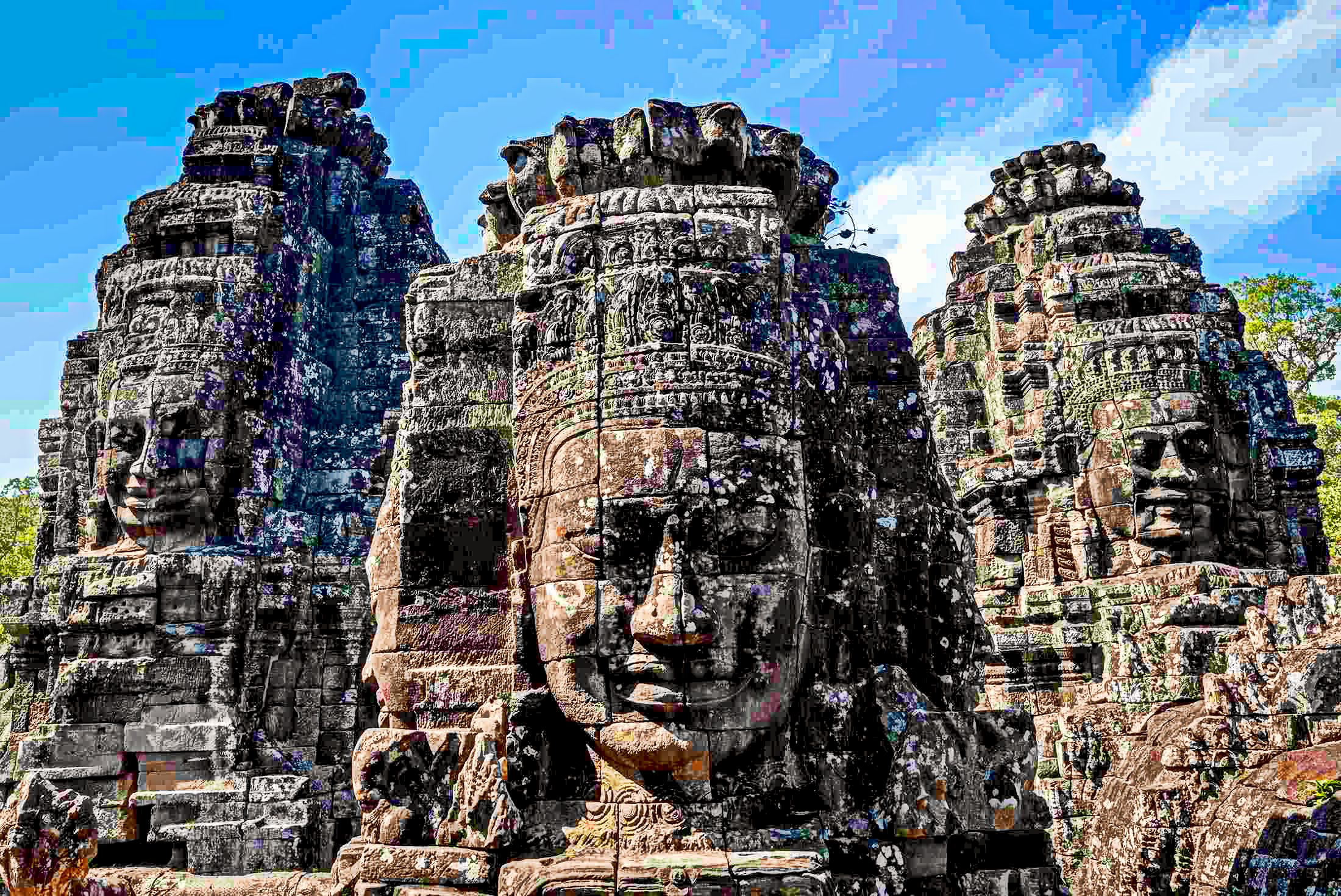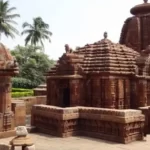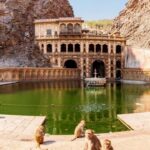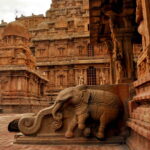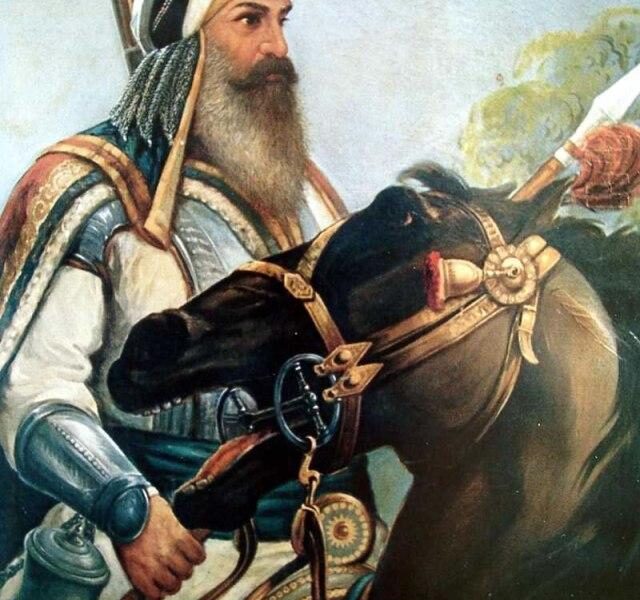13 Mysterious Indian Temples Where You Witness Unusual Phenomena-
Dausa, Rajasthan’s Mehandipur Balaji Temple.
Imagine being able to hear the piercing cries of possessed people at the shrine. One of India’s most famous and enigmatic temples, Mehandipur Balaji, is a remarkable pilgrimage site in Rajasthan. Here, a priest uses exorcism to rid a person of any kind of evil spirit. To treat a member of their family who is the victim of black magic or an evil spirit, thousands of people visit Mehandipur Balaji every day since it is a shrine to Lord Hanuman.
Guwahati, Assam’s Kamakhya Devi Temple
The mysterious Kamakhya Devi Temple in Guwahati, India, celebrates menstruation and womanhood because the goddess who resides there bleeds every year during the monsoon. A century old and one of India’s renowned 51 Shakti Peethas, this temple is located atop Nilachal Hill. You won’t find a god when you first approach the temple grounds; instead, worshippers will point you toward a stone-shaped vagina called a “Yoni.” With a red saree, pilgrims used to cover it. Because the Goddess bleeds and turns the underground water reservoir scarlet, the temple is usually closed from June through August. After visiting the Kamakhya Devi Temple in Guwahati, a strange current will run through your body.
Thiruvananthapuram, Kerala’s Sree Padmanabhaswamy Temple
The Padmanabhaswamy Temple is situated in Thiruvananthapuram, Kerala’s capital city. Before entering the Padmanabhaswamy Temple, there are many things to keep in mind. In the temple, casual attire is not permitted. Women are permitted if they are dressed in a “Saree,” while men must wear a “Dhoti.” A trust led by the Royal Family of Travancore currently oversees the management of the Padmanabhaswamy Temple. Electronic devices of any kind are not allowed. Z-Security is provided by the government authorities to protect the treasure in the vaults. According to Hinduism, this enigmatic temple in India has the power to grant the wishes of every devotee who enters. According to historical authorities, the Padmanabha Temple was built in the eighth century.
Tirumala, Andhra Pradesh’s Venkateshwara Temple
It is impossible to put into words the aura of this enigmatic temple in the Tirupati district of Andhra Pradesh. And for this reason, over 50,000 pilgrims visit to worship Lord Venkateshwara/Balaji/Vishnu each day. Its admission process is what makes Venkateshwara Temple the most enigmatic temple in all of India. To enter the temple, you must fill out a declaration form in which you must affirm your belief in Lord Venkateshwara. This explanation is what drives foreign visitors nuts for this enigmatic shrine in Tirupati. The shrine’s installed deity has actual hair and has been observed perspiring multiple times. Additionally, despite the priests’ best efforts to the contrary, the rear of the statue becomes wet.
The Meenakshi Amman Temple in Tamil Nadu’s Madurai
The Meenakshi Amman Temple, which is located in the centre of Madurai and spans a sizable 14 acres, exudes mysterious energy. Once within the complex of temples, you’ll sense the heavenly presence. This shrine, which is one of India’s most well-known and enigmatic temples, is significant both historically and mythologically. There is a legend surrounding the Meenakshi Amman Temple, the same location where Lord Shiva changed into Sundareswarar (the lovely one) to wed the Goddess Parvati (Meenakshi). This temple in Madurai was built in Dravidian-inspired architecture. In the temple complex, there are about 33,000 statues that date back to three thousand years (approx.).
Lepakshi, Andhra Pradesh’s Veerabhadra Temple
Veerabhadra Temple, located in the Lepakshi district of Andhra Pradesh, is a mysterious temple famous for having one hanging pillar out of its total of 70 pillars. Its building is a representation of the Vijaynagar style, and its history dates back to the sixteenth century. The one pillar that hangs from the ceiling of Veerabhadra Temple attracts a lot of people who find it intriguing. As a result, the temple has gained national recognition outside of Andhra Pradesh. To check the magical distance between the pillar and the ground, place cloth beneath the discernible space. Prepare to be surprised when you enter the temple grounds by the antique engineering marvel. There are many carved representations of God and Goddess.
Kailasa Temple: Maharashtra’s Ellora Caves
At the 16th-century Ellora Caves, Kailasa Temple is the greatest Hindu temple carved out of rock. You will have a reason to learn more about Indian mythology than ever before thanks to this temple. The Kailasa Temple is a monolithic building, meaning that it is a rock-based cave temple. The Ramayana has been depicted inside the Kailasa Cave Temple. Aurangzeb, the brutal Mughal king, noticed the elaborate carvings on this three-story temple complex and later gave the order to destroy the caverns, but nothing happened to the Kailasa Cave Temple. The archaeologist estimates that 30 million Sanskrit sculptures still need to be decoded to be understood.
Bhubaneshwar, Odisha’s Lingaraja Temple
Lingaraja Temple, the largest temple in Bhubaneshwar with a 54-meter Mandir devoted to Lord Shiva, is revered by Hindu worshippers with the deepest faith. The enigmatic aspect of the Lingaraja Temple is that as the Jagarnath cult began to take shape, Lord Shiva and Lord Vishnu’s presence became apparent just as the temple was about to be completed. The “Lingam” inside the Garbh Griha is self-originated and is hence referred to as “Swayambhu.” Thousands of worshippers come here to offer milk and bhang to the granite-built Lingam. You will encounter the two mustachioed yellow lions protecting the temple’s main gate as you enter. Hindu worshipers in long lines approach with their hands folded in thanks.
Kodungallur, Kerala’s Sree Kurumba Bhagavathy Temple
Your body would experience a stream of confusion once you visit this temple in Kerala’s Thrissur area. The Bharani Festival, which takes place at the Kodungallur Sree Kurumba Bhagavathy Temple every year between March and April, is well-known. The more odd aspect of the practice is that followers recite vulgar lyrics and devotional songs. Every year, for seven days, men and women both actively engage in the event while brandishing swords. They also struck their heads with swords, which caused blood to flow freely. The temple grounds remain closed once the odd event is over to wipe up bloodstains.
Kasaragod, Kerala’s Ananthapadmanabha Lake Temple
Ananthapadmanabha Lake Temple, which is located in the centre of the lake, is perhaps India’s enigmatic temple. Ananthapadmanabha Swamy Lake Temple’s guardian is a carnivore who follows a vegan diet, which is what makes it mysterious. The Crocodile, the most vicious meat-eating animal in the world, only eats the food served as prasad in temples, which includes cooked rice and jaggery. After the noon service, devotees effortlessly give the prasad to the ravenous soft-hearted with their hands. Babia has been residing in the lake or pond for the past 70 years or more, and he gets along well with people. This enigmatic temple in Kerala has a long history that reaches back to the ninth century.
Stambheshwar Mahadev: Gujarat’s Kavi Kavoi Village
The Stambheshwar Mahadev Temple, close to Vadodara, is where one can most clearly see a passionate commitment to nature’s wonder. It is well-known for being a submerged Shiva temple daily and is viewable at low tide. Include the enigmatic Stambheswar Mahadev temple in your itinerary if you also wish to ask for blessings from it while visiting Gujarat. You may simply get there from any city in Gujarat as it is close to Vadodara. Visit this well-known Hindu temple in Gujarat, which is wedged between the Arabian Sea and the Bay of Cambay, to experience God’s presence among the waves.
Varanasi, Uttar Pradesh’s Kal Bhairav Nath Temple
Would you like to go to a secret temple in India where alcohol or whisky is served as prasad? If it seems like what you need, proceed to Varanasi’s Kal Bhairav Nath Temple. Before entering the temple grounds, worshipers purchase wine or whiskey from one of the many kiosks outside the temple. In contrast to other temples in India, there are no flower or candy stores here. For courage and happiness on your Varanasi vacation, you should worship Kal Bhairav. It is worth it to seek blessings, so plan to wait in lengthy lines. Visit the Kal Bhairav Nath Temple on significant Hindu holidays to witness the most magical fervour of crowds.
Channapatna Dog Temple:
About 50 kilometers away, in the Ramanagara region of Karnataka, dogs are regarded as being more valuable than people. Man’s best companion is worshipped at the Channapatna Dog Temple.
The inhabitants of this town worship dogs as a means of guiding them on the way to salvation because they believe that dogs are an aspect of the Egyptian god of death.
God, but there are also normal idols. The list of 13 enigmatic temples in India, however, is not comprised of the country’s typical temples. Instead, they are the ones where worship of the strange deities takes place. There are more than 20,000 (about lakh) temples in our country, many of which have intriguing religious practices.
